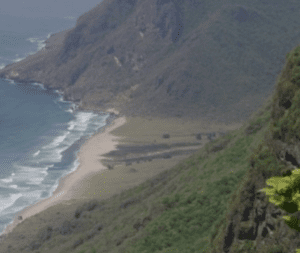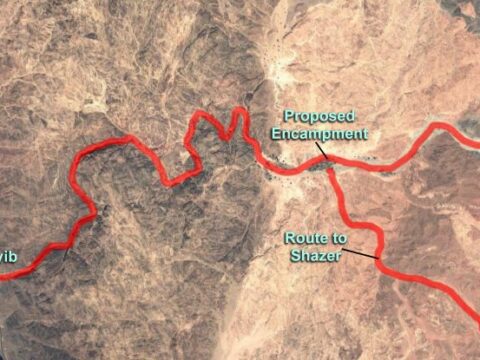
In spite of my appreciation for the highly interesting work of George Potter regarding the Arabian Peninsula and First Nephi, I find Warren Aston’s earlier approach to be more convincing. Potter proposes a site known as Khor Rori in Oman as the site for the ancient place Bountiful described in surprising detail by Nephi. Warren Aston’s preferred candidate, Khor Kharfot (at the mouth of Wadi Sayq), is about 60 miles to the south. Aston compares the two candidates in his recent article in Meridian Magazine, “Finding Nephi’s Bountiful in the Real World.” This is a valuable article with a number of photographs from the Wadi Sayq area. An excerpt follows:
Both these places have several features in common. Each lies “nearly eastward” of Nahom and can be reached from the interior desert. Both have sources of fresh water. They each have a sheltered harbor and each has cliffs overlooking the sea. We now know that both are within a few miles of an iron ore source. The differences between them, however, are striking.
On the one hand we have Khor Rori, in Lehi’s day a populated pagan town and in later times a busy shipping port, with little natural vegetation and no timber at all near the coast. The lack of timber has led some writers to suggest that it may have been imported from India as was done in northern Oman. Even today significant vegetation grows only in small irrigated areas at the coast or many miles inland. Khor Rori is surrounded by the broad and arid Salalah plains reaching inland to the Qara hills. There is no “mount” closer than twenty miles where Nephi could pray “oft.”
In contrast, Kharfot, hidden by the steep Qamar mountains, is the most fertile coastal location on the Arabian peninsula. Its fertility stretches several miles on each side of the bay. A variety of wild fruits and wild honey abounds and large timber trees grow — almost to the waters edge. A prominent mountain stands on the west side of the bay and at its base is an elevated plateau that would be ideal for a small community to live. It is a pristine place, almost certainly uninhabited in Lehi’s day.
These differences between the two places can be summarized as follows:
Khor Kharfot Khor Rori Much fruit, honey Yes No Shipbuilding timber Yes No Nearby mountain Yes No Flint nearby Yes None known Unpopulated Yes No On balance, Khor Kharfot seems a much more convincing fit than Khor Rori. Over the years I have taken scores of seasoned Latter-day Saints to both sites and not a single person has ever felt otherwise. Typically, those who feel otherwise have not actually been to both sites to compare.
In recent email, cited with permission, Brother Aston also notes that “the Potter/Wellington book does indeed add to our understanding of Lehi’s Arabia” but has some major flaws after Nahom:
Rather than a nearly eastward route to Bountiful, the Potter/Wellington route “goes E, SE, N, NW! E again and then SSE. In fact a pathway of rolling stony plateaus leads east from Nahom right to the Dhofar coast [both Bountiful candidates are in the Dhofar region]. It leads between two sand deserts and allows travel in a nearly eastward direction, just as Nephi wrote.
This finding (based on satellite imagery and my own travels in Yemen) is one of the major discoveries of recent years but still not recognized as such due to the tendency to not take the prophets at their word. Even the video Journey of Faith fell into what I call the dogleg-route trap when discussing travel to Bountiful.
As for Bountiful, there are no traces of construction of a port at Khor Rori earlier than 300BC and it most likely dates no earlier than about AD 900. Therefore there were no old sailors around to share their expertise with Nephi as the Potter book relies on so heavily. I prefer to accept that he was guided from time to time by revelation as he stated. If you missed it, Meridian Magazine published a summary of my arguments for Khor Kharfot and against Khor Rori last month … so I won’t repeat them here…. Khor Rori lacks the vegetation, timber trees and a mountain. Hope you make it over there sometime!
The existence of a plausible candidate for Bountiful – long mocked as an impossibility by anti-Mormons – must not be ignored. First Nephi provides directions that can actually be followed to find reasonable candidates for Nahom and Bountiful without straining the text or requiring great powers of imagination. There has been healthy debate over which of two or three candidates on the eastern Arabian coast might be the real thing. At the moment, I think Khor Kharfot by Wadi Sayq is the place. Thanks to all those who have worked, explored, and written so much to bring these things to light, including the Astons, the Hiltons, and the Potter/Wellington team.
2022 Update: George Potter has now published an update to the evidence for Khor Rori. Importantly, it is nearby Wadi Darbat, slightly above Khor Rori, that needs to be considered for the abundant foliage and fruit that it offers. See George D. Potter, “Khor Rori: A Maritime Resources-Based Candidate for Nephi’s Harbor,” Interpreter: A Journal of Latter-day Saint Faith and Scholarship 51 (2022): 253-294.











Amazing stuff. Has there been any reasonable response from the antis??
Is there ever?
I’d have to say that “reasonable response from the antis” is an oxymoron, or at least an impossibility.
Come on, people, let’s be fair. Some critics have pointed out that there have been two or more different candidates for Bountiful – in different places! – a severe contradiction. They can’t both be right. And the Tanners have pointed out that “Nahom” in the Book of Mormon agrees with the Arabic “Nehem” or “Nihm” in only 3 letters, NHM. The vowels don’t match!! (Never mind that the vowels are rather fluid, and that the ancient Semitic terms would be written using just the three consonants corresponding to N, H, and M.
Plus, more importantly, the relationships between First Nephi and several places in the Arabian Peninsula can be dismissed as just good guessing on Joseph’s part, mingled with plagiarism.
And of course, there is the standard official response: “Oh yeah? Well what about polygamy?”
I would be glad if Warren Aston and Joseph Smith did visit the Bountiful in the arabian peninsula during the 1830’s. Why now, and why now…you are saying Khor Kharfot is the candidate. Why nobody in the early days of LDS presidency or even Joseph Smith could not find this place. I am very sure Joseph Smith could not find this place during his time and much more at the present time. You (LDS) are still saying “candidate”. Are you lost now? or I shall say LDS-LOST DAY SAINT.
I think it would add immeasurably to the power of your message (at least I would find it so) if you posted some of the statements of the “experts” on the chance of there being a place such as Bountiful on the Arabian Peninsula.
Dennis
Dennis,
I agree with you. But you should note, if you have not already, that E.D. Howe, as well as several other “experts”, scoffed at the Book of Mormon’s mentioning of Boutiful in his book “Mormonism Unvailed”. After all, everyone knew that Arabia was nothing but a wasteland and desert. Silly Joe Smith was so stupid that he put that in his book, as well as Alma, which everyone knew was a female name.
So much for the “experts”.
Could you possibly post a link to the Google Maps page showing Khor Kharfot?
Thanks!
Hmmmm, go south from Jerusalem along the coast of the Red Sea. Once you hit NHM turn right and you should find a lush area, with enough iron and wood to build a ship.
Sounds like a hit to me. Both believers and nonbelivers can argue and specualte as to why it is there. But no one should deny that these are real places in the real world.
"I'd have to say that "reasonable response from the antis" is an oxymoron, or at least an impossibility."
We say the same about Mormons, not that I'm an anti (depending on your definition of the word).
Truly, this is the only bit of convincing evidence (IMO) for the BoM. After redefining a variety of animals, minimalizing the presence of steel, explaining away revisions to the text (such as the one over King Benjamin), ignoring the highly present modal theology, division over North American geography, Indians (boy, that one was fun), KJV plagiarism, the unrealistically quick rise in a population, lack of evidence for massive battles, gasping for air after head gets smitten off, steel, etc, etc.
Look, I have no problem converting if things add up. There's just too much mind bending going on in order to accept the Book of Mormon. And that's just the Book of Mormon.
Bountiful is a blow against Mormanism's critics, just like the discovery of the cities in Acts was to the bible's critics (that's a very strong parallel, come to think of it). I'm sure there's still debate over the Bountiful finding coming from the non-LDS side; but even if it was a perfect match, it's just a small light in a world of doubtfulness (unless you're the type who will defend Joseph to the death. That type of person can be found in any religion, however, and I'm sure we've witnessed a similar mindset to this some time in our lives. Especially with conspiracy theorists, Lord help us all).
I have taken scores of seasoned Latter-day Saints to both sites and not a single person has ever felt otherwise.
The lack of timber has led some writers to suggest that it may have been imported from India as was done in northern Oman
really interesting topics has been no response? would like more information ..
Hi, unhealthy foods.
Could you give us a link or source to the information you mentioned?
Sorry about the lack of responses, I don't think there's a way for people to realize someone's posted on a topic until they visit the topic itself (it'd be helpful!).
And a word about "Nahom". I'll have to look into the NHM issue (I've seen it before, but it was more a glance than a study), but there's a strong parallel in "Nahom" to the Old Testament book, "Nahum". Erase the top part of the small "o" in Nahom, and well. We have an OT book. Replace the "u" with an "o", and we have dear old Nahom. This doesn't have anything at all to do with the NHM finding, it just counts strongly toward the likelihood of plagiarism.
NHM itself and the plausibility surrounding it sound impressive to me, I understand the route taken by Nephi follows an actual historical trading route! I'm a little surprised that they didn't run into anybody, but I don't see that being an issue. Impressive findings!
Smith did much better on Saudi Arabia than Mesoamerica, which is quite the smoking gun these days (much unlike Saudi Arabia!).
Blessings